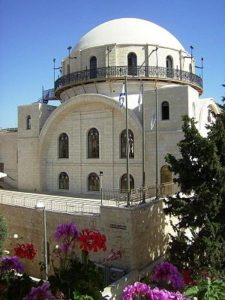 Rabbi Yehuda He’Hassid migrated from Poland. “He arrived in the country with a thousand Jews. They established themselves in Jerusalem near the Western Wall (and bought a holy enclosure) for a synagogue.
Rabbi Yehuda He’Hassid migrated from Poland. “He arrived in the country with a thousand Jews. They established themselves in Jerusalem near the Western Wall (and bought a holy enclosure) for a synagogue.
Rabbi Gedalia, one of Rabbi Yehuda’s companions recorded at that time.
‘The enclosure had several buildings within it, about forty houses and also a study hall… a ritual bath… and a house for the poor.’
Rabbi Yehuda died shortly after his arrival, but his friends continued with his plans to enlarge the synagogue and study hall,
‘And very large sums have been spent on the synagogue… and many bribes as well… For such are the ways of the kingdom of the Ishmaelites.’
But the bribes were not enough and in 1720, when the buildings were completed,
‘The leaders of the Ishmaelites imposed on the members of the group heavy taxes which they could not pay,’
– and looted the silver vessels, burnt the synagogue and tore down the adjoining buildings. The stone shell of the synagogue remained, and was well known ever after as the ‘Hurva,’ Hebrew for ‘ruin,’ and only more than a century later was permission secured for its reconstruction.
(It was again destroyed, in 1948, by the Jordanian Arab Legion”)
Source: Kollek, Teddy; Pearlman, Moshe. Pilgrims to the Holy Land: The story of Pilgrimage Through the Ages. p191-192.